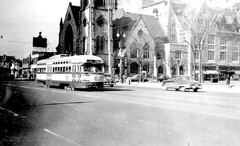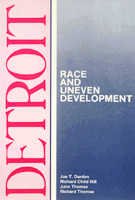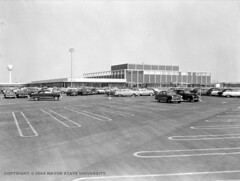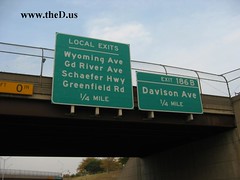Blogreader comments on Detroit (in response to the Friday entry on New Orleans, Detroit & Baltimore)
 Detroit streetcar on Woodward Avenue. Photo from Motown Transit. My fathers office was just north of the church, on Woodward. This is at Grand Circus Park (the photo is from before I was born.)
Detroit streetcar on Woodward Avenue. Photo from Motown Transit. My fathers office was just north of the church, on Woodward. This is at Grand Circus Park (the photo is from before I was born.)On Friday Wonkette linked to my blog entry "Detroit, Baltimore... New Orleans, different only by degree." This vastly increased my unique visits totals from Friday through today, in fact, for me "records." (And a far larger boost than the mention in Daily Kos last October...) We can only hope that some of the visitors will become more regular readers....
Anyway, there are a couple great comments, one from the blog's #1 (in volume*) commenter, "DC1974." (* DC1974 is the #1 commenter in volume; his comments are always great. Fortunately, he is in good company. All of the people that comment either within the blog, or by separate emails to me, write some really great stuff. THANK YOU!)
Both write about Detroit, and DC1974 shocked me in stating that his family is from the Detroit area, specifically Oakland County and that they never stepped foot in Detroit. I lived in Oakland County too, from the latter half of 7th grade onward. Before that I lived mostly in Detroit, but also here and there in Wayne and Macomb counties. And in college and afterwards I lived in Washtenaw County.
The first writer, Bobby Alcott, who now lives in Detroit (I hope that you are checking out great Detroit blogs such as Girl in Detroit, Detroit Blog--absolutely amazing photographs and urban spelunking--is that what they call it?, Pride in Detroit, which comes with a fabulous set of links, and Model D (Detroit) Magazine) says that a big dose of Detroit's problems come from racism.
I have to agree, I think that you have to look at this not just from the perspective of today, but also from the perspective of 40, 60, and 80 years ago. Detroit, I joke often, is exactly what the auto industry intended to have happen to cities. After all, you need "wide open spaces" or freeways in order to maximize the utility of a car. Who thought that creating the equivalent of 55 square miles of "prairie" in the City of Detroit would have been one of the consequences of suburban outmigration and the "American Dream."
Where some of this outmigration was likely fueled by a desire to keep the races unmixed, at least on the part of some whites, I do think that people desired an experience different from tenements, crowdedness, and living by noisy, smoky industry.
First people moved from the core of cities to "suburb-like places within the city, or the farther reaches of the city--in DC, places like Brookland or up 16th Street NW or Georgia Avenue. In Detroit, people lived in Palmer Park or Indian Village or Rosedale Park (where I lived until my father died, and where Roman Gribbs, a one-term mayor, was one of my Cub scout den leaders--our Cub Scout leaders were men--he took us to Dunkin' Donuts once, and Martha Griffiths, our Congresswoman, lived down the street within two blocks--so our streets were always cleared of snow--but this is 1966-68, note that the riots were in 1967).
Kunstler makes a great point in Home from Nowhere that from the Depression (starting in 1929) through the end of World War II, cities experienced little investment on the whole, although granted there were many WPA and PWA projects that did do some construction. Washington of course experienced a great deal of building, but not enough for demand.
So people wanted to leave cities. And once they could, they did.
I have to admit that I haven't read all the great books that are out there that look at issues about Detroit. One of the most frequently quoted is Thomas Sugrue's The Origins of the Urban Crisis which makes the point that Detroit's problems started long before the riots and the victory of the city's first black mayor, Coleman Young. (It happens that I agree, and I haven't even read the book.) The Detroit Free Press has an essay about an interview they did with Professor Sugrue here, "A historian dissects Detroit's trouble."
But there are others, sociologists, writing out of the Growth Machine theory, and political scientists, writing from the "urban regime" perspective.
 This book, by Joe T. Darden, Richard Child Hill, June Thomas and Richard Thomas, comes from the Growth Machine school.
This book, by Joe T. Darden, Richard Child Hill, June Thomas and Richard Thomas, comes from the Growth Machine school.An interesting sidebar is that the Hudson Department Store company retained Victor Gruen in the late 1940s/early 1950s to plan their expansion, and they planned malls on the south, north, and east of the city (Northland was one of the first, but not the first shopping centers). This reflected changes in population patterns, but also shaped the changes, and encouraged people to leave the city. (This is outlined by Alex Wall in his recent book about Gruen.)
 Northland Shopping Center, Southfield, Michigan, 1954, Wayne State University photo.
Northland Shopping Center, Southfield, Michigan, 1954, Wayne State University photo.According to the Free Press interview with Professor Sugrue:
Three sweeping changes transformed the city. These three things, occurring simultaneously and interacting, dramatically reshaped the metropolis of Detroit and other metropolises like it. First was deindustrialization, the flight of jobs away from the city, something that began unnoticed and unheralded in the 1950s.
Next was persistent racial discrimination in labor markets. Racial discrimination remained a very persistent problem despite decades of civil rights activism and some improvement in attitudes and beliefs. Finally was intense residential segregation, a division of the metropolitan area into two metropolitan areas: one black and one white.
While I believe that this is true, I don't believe that pre-war outmigration was driven by racism. I remember going to Hudson's in the late 1960s for Santa, and "elves" asked each family if they wanted to see a white or a black santa. My foster parents said it didn't mater...
But then there is now, and how to deal with the now. Doing something about Detroit's problems today, is all about segregation and racism. All the more reason that we need to pore through the Growth Machine and Urban Regime papers, as well as Marion Orr's book Black Social Capital.
DC1974 says something interesting:
My family is from Oakland County Michigan. (At least 4 generations, probably more like 8.) I've never once stepped foot in Detroit. (My grandparents, though, felt a stronger allegiance to Pontiac, though, where they grew up, and that has also struggled, but not like Detroit.) Even when relatives lived around the area in the mid-1960s, as recent college grads, the closest we ever got is Royal Oak. That's weird to me. That a whole city, the reason for the region, has just been abandoned. That, as the previous commenter mentioned, can only be racism.
Granted, there isn't a lot, other than cultural to attract people to Detroit now. But Oakland County is a trip too. I went to college as a moderate Republican. Michigan then had an honorable tradition in that vein, but I converted soon enough. I never understood why Oakland County was so Republican (it's the money, stupid...).
But when I ran for City Council in Ann Arbor (because no other Democrat wanted to run that year in what was at the time a traditionally Republican ward), I was doing door knocking in one of the precincts that was well known for producing massive numbers of solidly Republican voters. This subdivision, Lansdowne, looked like all the upper income subdivisions in Oakland County (think KB Homes, which actually started in Michigan, Pulte, Toll Brothers, K. Hovnanian, etc.).
All of a sudden I understood Oakland County much better.
I still think that it's not all racism, and that dealing with the problems is nuanced and difficult. I am a big fan of the book The Future Once Happened Here, which discusses the kind of institutional malaise that cities became mired in. The difficulties of getting out is evident in the state of municipal government in Washington, DC today, as well as in other center cities.
As far as re-creating in the center city the kind of diverse, art and design centric place that DC1974 is looking for, I think that programs like Michigan's Cool Cities have promise--the issue isn't to make Detroit over into San Francisco in five years, but to make it more competitive neighborhood by neighborhood with the suburbs. E.g., the Detroit metropolitan region uses land 6-8 times more intensely than is needed to accommodate population increases. (The Get Urban offers a similar paradigm, although it is seemingly targeted to smaller population centers such as Omaha.)
Without urban growth boundaries, until oil peters out, or increases even more greatly in price, we're not going to be able to recenter development towards the core, the traditional center city of a region, such as Cleveland, Detroit, Pittsburgh, Baltimore, etc.
Detroit has other problems. It doesn't have an attached housing tradition comparable to that of cities on the East Coast. It has often nondescript little box houses with driveways and garages, separated from the houses on either side by about 10 feet and a fence...
Contrast that to DC which has other advantages, but also attractive historic building stock that once again is in demand, after a long period of disinterest, and similar political and municipal managerial issues.
 Detroit highway signs by TheD.
Detroit highway signs by TheD.Index Keywords: urban-revitalization



0 Comments:
Post a Comment
<< Home